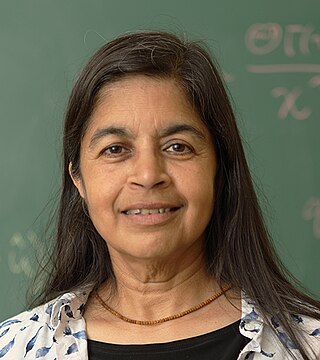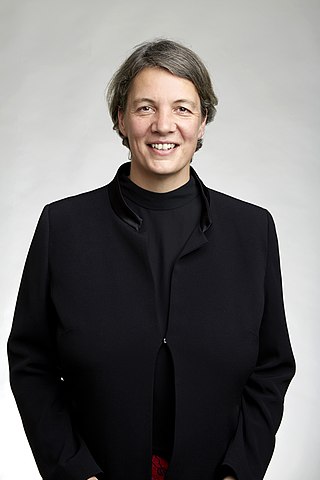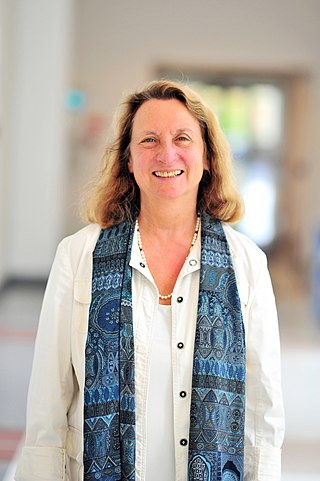
Martin Andrew Green is an Australian engineer and professor at the University of New South Wales who works on solar energy. He was awarded the 2021 Japan Prize for his achievements in the "Development of High-Efficiency Silicon Photovoltaic Devices". He is editor-in-chief of the academic journal Progress in Photovoltaics.
The 1851 Research Fellowship is a scheme conducted by the Royal Commission for the Exhibition of 1851 to annually award a three-year research scholarship to approximately eight "young scientists or engineers of exceptional promise". The fellowship is open to all nationalities and fields of science, including physical or biological sciences, mathematics, applied science, and any branch of engineering. The fellowship can be held anywhere in the United Kingdom.
Amanda Susan Barnard is an Australian theoretical physicist working in predicting the real world behavior of nanoparticles using analytical models and supercomputer simulations and applied machine learning. Barnard is a pioneer in the thermodynamic cartography of nanomaterials, creating nanoscale phase diagrams relevant to different environmental conditions, and relating these to structure/property maps. Her current research involves developing and applying statistical methods and machine/deep learning in nanoscience and nanotechnology, and materials and molecular informatics. In 2014 she became the first person in the southern hemisphere, and the first woman, to win the Feynman Prize in Nanotechnology, which she won for her work on diamond nanoparticles.

Nalini Joshi is an Australian mathematician. She is a professor in the School of Mathematics and Statistics at the University of Sydney, the first woman in the School to hold this position, and is a past-president of the Australian Mathematical Society. Joshi is a member of the School's Applied Mathematics Research Group. Her research concerns integrable systems. She was awarded the Georgina Sweet Australian Laureate Fellowship in 2012. Joshi is also the Vice-President of the International Mathematical Union, and is the first Australian to hold this position.

Benjamin John Eggleton,, is Pro Vice Chancellor (Research) at the University of Sydney. He is also Professor in the School of Physics where he leads a research group in integrated photonics, nonlinear optics and smart sensors and serves as co-director of the NSW Smart Sensing Network (NSSN).
Jacob Nissim Israelachvili, was an Israeli physicist who was a professor at the University of California, Santa Barbara (UCSB).
Donald Blair Melrose FAA is an Australian theoretical physicist, Rhodes Scholar and laureate of the Chandrasekhar prize in Plasma Physics.

Michelle Yvonne Simmons is an Australian quantum physicist, recognised for her foundational contributions to the field of atomic electronics.

Tanya Mary Monro is an Australian physicist known for her work in photonics. She has been Australia's Chief Defence Scientist since 8 March 2019. Prior to that she was the Deputy Vice Chancellor, Research and Innovation (DVCR&I) at the University of South Australia. She was awarded the ARC Georgina Sweet Australian Laureate Fellowship in 2013. She was the inaugural director of the Institute for Photonics & Advanced Sensing (IPAS). Monro has remained an adjunct professor of physics at the University of Adelaide following her departure from the institution. In 2020 she was awarded the title of Emeritus Professor at the University of South Australia.
Mahananda (Nanda) Dasgupta FAA, FAIP, FAPS is an experimental physicist at the Heavy Ion Accelerator Facility in the Department of Nuclear Physics of the Australian National University, whose work focuses on accelerator-based nuclear fusion and fission.

Elaine Surick Oran is an American physical scientist and is considered a world authority on numerical methods for large-scale simulation of physical systems. She has pioneered computational technology to solve complex reactive flow problems, unifying concepts from science, mathematics, engineering, and computer science in a new methodology. An incredibly diverse range of phenomena can be modeled and better understood using her techniques for numerical simulation of fluid flows, ranging from the tightly grouped movements of fish in Earth's oceans to the explosions of far-flung supernovae in space. Her work has contributed significantly to the advancement of the engineering profession.
Naomi McClure-Griffiths is an American-born Australian astrophysicist and radio astronomer. In 2004, she discovered a new spiral arm in the Milky Way galaxy. She was awarded the Prime Minister's Malcolm McIntosh Prize for Physical Scientist in 2006 and in 2015 was honored for her research in physics by receipt of the Pawsey Medal from the Australian Academy of Science. This was followed by an Australian Laureate Fellowship in 2021, while in 2022 she was elected a Fellow of the Australian Academy of Science.
Chennupati Jagadish, an Indian-Australian physicist and academic, is the President of the Australian Academy of Science, and a Distinguished Professor of Physics at the Australian National University Research School of Physics. He is head of the Semiconductor Optoelectronics and Nanotechnology Group which he established in 1990. He is also the Convener of the Australian Nanotechnology Network and Director of Australian National Fabrication Facility ACT Node.
Kostya (Ken) Ostrikov is a Ukrainian-Australian physicist and academic, professor at Queensland University of Technology and scientist at the Commonwealth Scientific and Industrial Research Organisation, member of Academia Europaea. He was awarded the Pawsey Medal (2008) and the Walter Boas Medal (2010).

Trevor John McDougall is an Australian physical oceanographer specialising in ocean mixing and the thermodynamics of seawater. He is Emeritus Scientia Professor of Ocean Physics in the School of Mathematics and Statistics at the University of New South Wales, Sydney, Australia, and is Past President of the International Association for the Physical Sciences of the Oceans (IAPSO) of the International Union of Geodesy and Geophysics.

Ulrike Diebold is an Austrian physicist and materials scientist who is a professor of surface science at TU Vienna. She is known for her groundbreaking research on the atomic scale geometry and electronic structure of metal-oxide surfaces.
Ruth Cameron FInstP FIOM3 FREng is a British materials scientist and professor at the University of Cambridge. She is co-director of the Cambridge Centre for Medical Materials, where she studies materials that interact therapeutically with the body. Since October 2020 she has been joint head of the Department of Materials Science and Metallurgy at Cambridge.
Madhu Bhaskaran is an Indian engineer and Professor at RMIT University. She co-leads the Functional Materials and Microsystems Research Group at RMIT University She won the APEC Aspire prize in 2018 for her development of "electronic skin".
Catherine Stampfl is a professor of physics at the University of Sydney and was elected as a Fellow of the Australian Academy of Science in 2019.
Gregory John Clark is an Australian physicist and business executive. His research focused on the field of high-pressure mineral physics. Subsequently, his business career included senior management roles at News Corporation, Loral Space and Communications, ANZ Banking Group, NextDC, and KaComm Communications. He was awarded the Pawsey Medal in 1979 for his research, and in 2018, he was appointed as a Companion of the Order of Australia.







